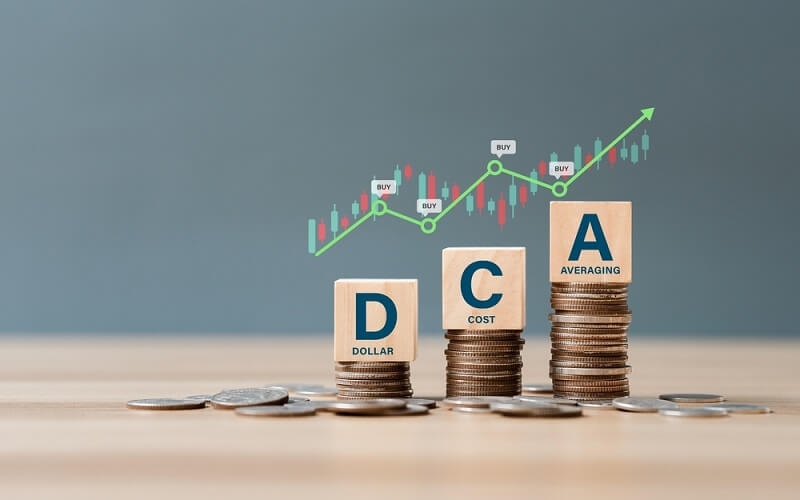
Stock market investments are often written about like a maze of unexpected twists and turns. Even the most consistent investors can ask if they did the right thing during market highs and lows. Many people are paralyzed by the fear of mistiming the market or making big mistakes. Dollar-cost averaging (DCA) is a wonderfully nested way to lock clients out of market timing complexity, to trade on simplicity, or even to grow over the long run. Today, I will discuss dollar cost averaging, real-world examples, and how it can help you reduce risk and maximize return upon a market dip.
Simply put, dollar cost averaging is an investment strategy that advocates that investors spend their total investment on periodic purchases of that target asset. You commit to investing a fixed amount at regular intervals rather than a lump sum at any one time, and the asset is not bought at the current price. This method will cause you to buy more shares when the prices are low and fewer when the prices are high; you will then end up costing per share over time.
For example, if we assume you have $12,000 to invest, you decide to invest the total in one year by investing $1,000 a month. By the end of the year, you’ll have bought shares at different price points to reduce your risk of bad timing and exploit the market’s fluctuation.
Also Read: Guide to Investing: Stocks, ETFs, and Index Funds Explained

Prices in the stock market are very volatile, with daily fluctuations. For the most part, investors will struggle to predict when the market will peak or have a low. The volatility of this type of investment is lessened slightly with dollar cost averaging, where you spread your investment out over time. By not doing it during market peaks, you remove the risk of investing a lump sum into a market at the top price and take advantage of opportunities during market dips.
Often, poor decisions are made when investing due to emotions, such as panic selling when the markets are off or impulse buying when the markets are up. Dollar-cost averaging forces the investor not to have the emotion to get involved with the trade. This discipline keeps you from letting short-term market swings lead you off track to meet your long-term financial goals.
As the accessibility of one of the most appealing aspects of dollar cost averaging, this method is highly popular. Starting to invest doesn’t take a lot of money. This means that beginners or people with little funds can grow their portfolios slowly and steadily without stressing about a sudden lump sum.
Let’s say you want to invest $500 monthly in a mutual fund. Over six months, the fund’s price fluctuates as follows:
| Month | Price Per Share | Amount Invested | Shares Bought |
| 1 | $50 | $500 | 10 |
| 2 | $40 | $500 | 12.5 |
| 3 | $45 | $500 | 11.11 |
| 4 | $60 | $500 | 8.33 |
| 5 | $55 | $500 | 9.09 |
| 6 | $50 | $500 | 10 |
After six months are gone, you’ve invested $3,000 and bought 61.03 shares. Although the share price went from $40 to $60, your average cost per share is about $49.14. You’ve constantly been investing consistently, taking advantage of lower prices but not worrying about the perfect market timing.
Dollar-cost averaging is one of the most resilient methods of purchasing stocks during a market downdraft. Imagine you want to invest $200 per month in an exchange-traded fund (ETF) just before a market crash. The more your ETF’s value falls, the more your regular contributions allow you to buy more shares at cheaper prices. If the market recovers later, you’ll have bought more shares that have grown in value—that will be amplified by your returns.
What if you start saving $300 a month into a retirement account when you’re 25? If their annual rate return was 7%, their portfolio would be worth about $380,000, and they can start at age 55. This investor starts very early and continues for very long, compounding to enormous wealth with minimal susceptibility to market fluctuations by jacking the leverage of compounding and time.
While dollar-cost averaging is a powerful strategy, it’s not a one-size-fits-all solution. It’s best suited for:
However, if you have a lump sum to invest and the market is trending steadily upward, lump-sum investing may yield higher returns. Consulting with a financial advisor can help tailor your investment approach to align with your unique goals and risk tolerance.
You May Read: Best Time to Buy Stocks for Maximum Profit and Growth
Dollar-cost averaging is a simple, disciplined way of investing that involves paying the same amount each payday and not reacting to the ups and downs of the market. Spreading the investments over regular intervals makes it possible to ride the unpredictable nature of the stock market. For instance, dollar cost averaging is an excellent way to invest when you’re just starting or want to ride out market volatility without disrupting your long-term financial goals.
There’s no foolproof investment strategy; only dollar cost averaging stresses consistency and patience. This approach aligns with your overall financial objectives and risk tolerance, and you can use the power of steady investing to build long-lasting wealth in the face of market uncertainty.
This content was created by AI